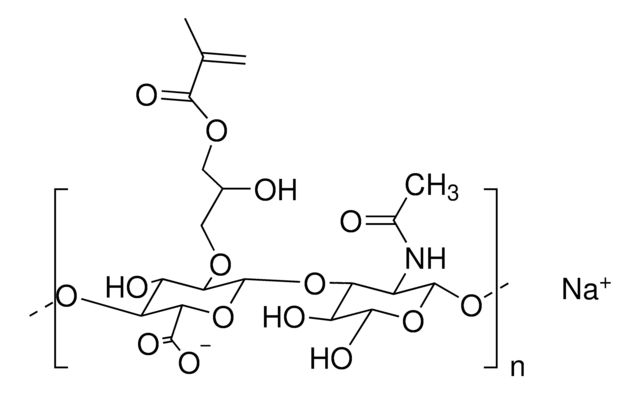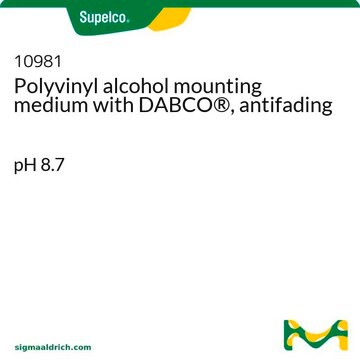추천 제품
생물학적 소스
rat
Quality Level
포장
vial of ≥1 x 10^6 vial
제조업체/상표
Millipore
기술
cell culture | mammalian: suitable
배송 상태
liquid nitrogen
저장 온도
−196°C
일반 설명
GRINCH (Glucose-Responsive Insulin-secreting C-peptide modified Human proinsulin) is a rat insulinoma cell line derived from the INS-1 cell line. INS-1 cells were transfected with the hPro-CpepSfGFP construct containing the human insulin sequence with a C-peptide modified with a C-terminal superfolder GFP insert. The GRINCH cell line exhibits efficient glucose-stimulated insulin secretion, making it a good model to study insulin secretion regulation and pancreatic β-cell function. The fluorescent C-peptide is co-stored and co-secreted with human insulin, allowing the tracking and quantification of insulin biosynthesis in real time.
GRINCH cells express human insulin with a C-peptide GFP tag?.
GRINCH cells express human insulin with a C-peptide GFP tag?.
애플리케이션
- Each vial contains > 1 X106 viable cells.
- Cells are tested negative for infectious diseases by Essential CLEAR Panel by Charles River Animal Diagnostic Services.
- Cells are verified to be of rat origin and negative for interspecies contamination from human, mouse, Chinese hamster, Golden Syrian hamster, and nonhuman primate (NHP) as assessed by a Contamination Clear panel by Charles River Animal Diagnostic Services
- Cells are negative for mycoplasma contamination.
특징 및 장점
SCC611, the GRINCH rat insulinoma cell line, is a pancreatic beta cell line transfected with the hPro-CpepSfGFP construct containing the human insulin sequence.
표적 설명
Approximately 1 in 11 adults globally has diabetes, leading to 12% of health expenditure being diabetes- related. Diabetes mellitus refers to a group of metabolic diseases involving chronic hyperglycemia due to reduced insulin secretion, insulin synthesis, or increased insulin resistance.
Recent advancements in technology have enabled the molecular understanding of diabetes in childhood and in non-obese patients, unveiling the role of single gene defects. These defects, found in genes encoding beta-cell components like potassium channels, glucokinase, transcription factors, and insulin, contribute to 1-5% of all diabetes cases and are characteristic of monogenic diabetes. Insulin gene mutations can lead to various diabetes subtypes by affecting insulin folding, causing retention in the endoplasmic reticulum (ER), triggering ER stress, beta-cell death, and impairing insulin-insulin receptor (IR) interaction.
Source
The GRINCH cell line was derived from INS-1 cells. The INS-1 cell line was derived from x-ray induced insulinoma in rats.
References
1. Trikkalinou A, Papazafiropoulou AK, Melidonis A. 2017. Type 2 diabetes and quality of life. World Journal of Diabetes. 8(4):120.
2. Yang Y, Chan L. 2016. Monogenic Diabetes: What It Teaches Us on the Common Forms of Type 1 and Type 2 Diabetes. Endocrine Reviews. 37(3):190–222.
3. Haataja L, Snapp EL, Wright JJ, Li M, Hardy A, Wheeler MB, Markwardt ML, Rizzo MA, Arvan P. 2013. Proinsulin Intermolecular Interactions during Secretory Trafficking in Pancreatic β Cells. 288(3):1896–1906.
Recent advancements in technology have enabled the molecular understanding of diabetes in childhood and in non-obese patients, unveiling the role of single gene defects. These defects, found in genes encoding beta-cell components like potassium channels, glucokinase, transcription factors, and insulin, contribute to 1-5% of all diabetes cases and are characteristic of monogenic diabetes. Insulin gene mutations can lead to various diabetes subtypes by affecting insulin folding, causing retention in the endoplasmic reticulum (ER), triggering ER stress, beta-cell death, and impairing insulin-insulin receptor (IR) interaction.
Source
The GRINCH cell line was derived from INS-1 cells. The INS-1 cell line was derived from x-ray induced insulinoma in rats.
References
1. Trikkalinou A, Papazafiropoulou AK, Melidonis A. 2017. Type 2 diabetes and quality of life. World Journal of Diabetes. 8(4):120.
2. Yang Y, Chan L. 2016. Monogenic Diabetes: What It Teaches Us on the Common Forms of Type 1 and Type 2 Diabetes. Endocrine Reviews. 37(3):190–222.
3. Haataja L, Snapp EL, Wright JJ, Li M, Hardy A, Wheeler MB, Markwardt ML, Rizzo MA, Arvan P. 2013. Proinsulin Intermolecular Interactions during Secretory Trafficking in Pancreatic β Cells. 288(3):1896–1906.
저장 및 안정성
GRINCH Glucose-Responsive Insulin-secreting C-peptide hProinsulin Rat Insulinoma cells should be stored in liquid nitrogen. The cells can be cultured for at least 10 passages without significantly affecting cell marker expression and function.
기타 정보
This product is intended for sale and sold solely to academic institutions for internal academic research use per the terms of the “Academic Use Agreement” as detailed in the product documentation. For information regarding any other use, please contact licensing@milliporesigma.com.
면책조항
Unless otherwise stated in our catalog or other company documentation accompanying the product(s), our products are intended for research use only and are not to be used for any other purpose, which includes but is not limited to, unauthorized commercial uses, in vitro diagnostic uses, ex vivo or in vivo therapeutic uses or any type of consumption or application to humans or animals.
Storage Class Code
10 - Combustible liquids
WGK
WGK 2
Flash Point (°F)
Not applicable
Flash Point (°C)
Not applicable
시험 성적서(COA)
제품의 로트/배치 번호를 입력하여 시험 성적서(COA)을 검색하십시오. 로트 및 배치 번호는 제품 라벨에 있는 ‘로트’ 또는 ‘배치’라는 용어 뒤에서 찾을 수 있습니다.
자사의 과학자팀은 생명 과학, 재료 과학, 화학 합성, 크로마토그래피, 분석 및 기타 많은 영역을 포함한 모든 과학 분야에 경험이 있습니다..
고객지원팀으로 연락바랍니다.






